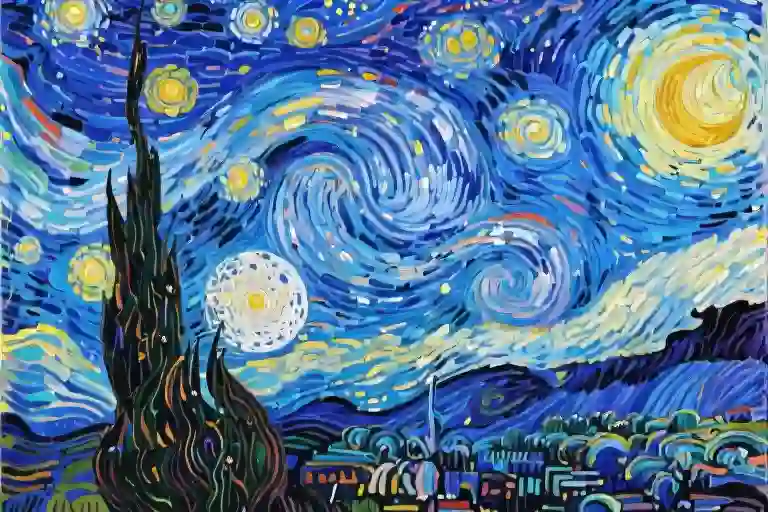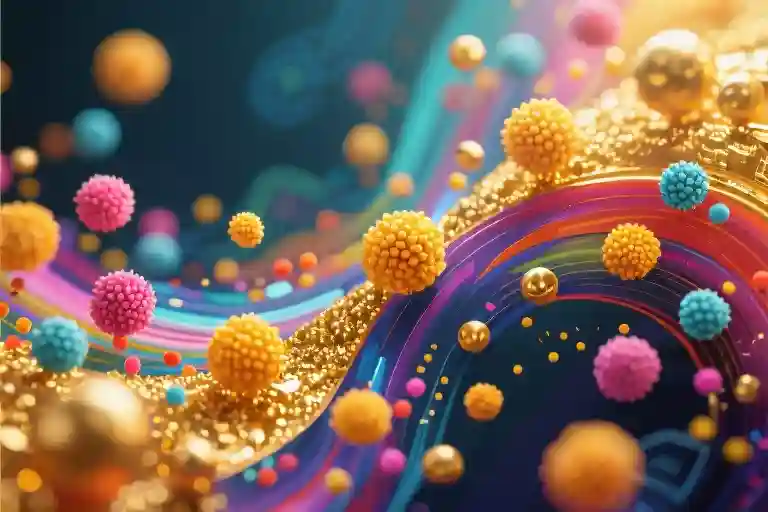What if life exists beyond Earth — would it create art? This seemingly whimsical question opens doors to profound intersections between scientific inquiry and artistic expression. For years, my writing has explored storytelling through an artistic lens, but some of the most illuminating perspectives often come from outside gallery walls and concert halls. That’s why this new series invites thinkers from radically different fields to examine how their work reshapes their understanding of art and culture.
Dr. Kevin Peter Hand embodies this interdisciplinary approach. As a NASA astrobiologist specializing in Jupiter’s moon Europa, he spends his days investigating conditions for extraterrestrial life. Yet over a decade of conversations, I’ve discovered how his cosmic research continually informs unexpected reflections on human creativity. When someone who analyzes ice-covered oceans starts discussing narrative structure or cultural trends, you realize how artificial our disciplinary boundaries truly are.
This inaugural dialogue grew from a simple premise: groundbreaking work in any field inevitably alters how we perceive art’s role in society. Scientists developing life-detection tools, engineers building interstellar probes, or philosophers debating consciousness — their specialized knowledge constructs unique frameworks for interpreting creativity. By stepping beyond traditional artist interviews, we uncover fresh metaphors about storytelling’s purpose in an era of quantum computing and genome editing.
Consider Europa’s icy shell, beneath which Dr. Hand’s team suspects a vast liquid ocean. The technical challenges of exploring this alien sea — designing drills that could penetrate miles of ice while preventing microbial contamination — parallel an artist’s struggle to reveal hidden truths without distorting them. Both endeavors require balancing precision with imagination, a tension that surfaces repeatedly in our discussion about art and science as complementary modes of discovery.
What makes these cross-disciplinary exchanges vital? In a world increasingly shaped by technological leaps, art cannot thrive in isolation from the forces transforming human experience. When a planetary scientist contemplates how future civilizations might interpret our cultural artifacts, or when artificial intelligence begins generating its own “creative” outputs, we need bridges between specialists who rarely speak the same language. This series aims to construct those bridges — one unexpected conversation at a time.
Why Would a NASA Astrobiologist Talk About Art?
It’s an unusual pairing at first glance — a scientist who spends his days analyzing ice samples from Jupiter’s moons, sitting down to discuss brushstrokes and sonnets. But that’s precisely why conversations like this matter. In a world where specialization often creates intellectual silos, we rarely pause to consider how a planetary scientist might view Renaissance paintings or what microbial research could teach us about creative collaboration.
Dr. Kevin Peter Hand represents a fascinating exception to this divide. While most of his colleagues focus narrowly on spectral data and mission parameters, he’s developed what I’d call a “cosmic perspective” on human creativity. His work searching for life on Europa — that icy moon with a hidden ocean — constantly confronts him with fundamental questions about existence, meaning, and expression.
“When you’re studying whether life could emerge in complete darkness beneath miles of alien ice,” he once told me over coffee, “you start seeing all human stories differently.” This mindset shift is what makes his artistic insights so valuable. Where traditional art critics might analyze composition or art historical context, Dr. Hand approaches creativity through the lens of universal constants — the physics of light that enables painting, the biological imperatives behind storytelling, or the mathematical patterns underlying musical harmony.
NASA’s own research reveals an uncomfortable truth: only 11% of scientists actively engage with the arts beyond casual entertainment. Yet studies from the National Endowment for the Arts show that scientists who do participate in artistic activities demonstrate 17% higher innovation metrics in their research. This correlation suggests we’ve been missing something fundamental about how these domains interact.
What makes Dr. Hand’s perspective particularly compelling is how his scientific rigor informs his artistic appreciation. While analyzing Europa’s surface cracks for signs of subsurface activity, he developed what he calls “a detective’s eye for hidden narratives” — a skill that translates surprisingly well when examining a Caravaggio’s chiaroscuro or a Maya Lin memorial. His ability to see beyond surface appearances, to reconstruct entire ecosystems from trace chemical signatures, gives him a unique vantage point on how artists encode meaning in their work.
Perhaps most importantly, this interdisciplinary approach reflects a growing recognition that the big questions — about consciousness, beauty, our place in the universe — can’t be answered by any single field alone. As Dr. Hand puts it: “Science shows us how life might arise on an ice-covered moon, but art shows us why that discovery would matter.”
From Europa’s Ice to Earth’s Canvas: A Scientist’s Narrative Lens
Dr. Kevin Peter Hand’s office at NASA’s Jet Propulsion Laboratory holds two seemingly unrelated objects: a framed image of Europa’s cracked icy surface and a postcard of Van Gogh’s Starry Night. This juxtaposition encapsulates his unique perspective—where planetary science meets artistic wonder. As one of the world’s leading experts on Jupiter’s mysterious moon, his decade-long work on the Europa Lander mission redefined how we search for extraterrestrial life. But what fascinates me most isn’t just his scientific rigor—it’s how exploring alien oceans transformed his understanding of human storytelling.
The Scientist Who Reads Ice Like Poetry
Hand’s credentials read like a space enthusiast’s dream: Deputy Chief Scientist for Solar System Exploration at JPL, Project Scientist for NASA’s Europa Lander concept, and director of astrobiology research programs. Yet during our conversation, he kept returning to an unexpected moment in 2014. While analyzing high-resolution images of Europa’s surface fractures, he noticed patterns resembling ancient cave paintings—swirling lines that hinted at hidden narratives beneath the ice.
“That’s when I realized,” he says, tapping his coffee mug for emphasis, “we scientists are essentially paleontologists of the future. The cracks on Europa are hieroglyphs waiting to be decoded, just like early humans left marks to say I was here.” This epiphany became his professional turning point, bridging data analysis with what he calls “cosmic storytelling”—the idea that every scientific discovery reveals chapters of a universal narrative.
When Spectroscopy Meets Symbolism
Hand’s research specializes in spectroscopic analysis of Europa’s surface (a method that identifies chemical compositions through light signatures). In layman’s terms? He studies how sunlight bounces off alien ice to guess what might live beneath. But here’s where art enters his lab: the same technique used to search for microbial life also helped him appreciate Renaissance paintings differently.
“Artists layer colors like we layer data,” he explains. “When I saw how Titian built up glazes to create luminosity, it mirrored how we stack spectral bands to reveal hidden compounds.” This interdisciplinary thinking led to his famous 2018 TED Talk comparing Europa’s “chaos terrains” (regions of broken ice) to Jackson Pollock’s paintings—both appearing random yet following underlying natural laws.
The Ripple Effect of a Cosmic Perspective
Perhaps Hand’s most profound artistic insight came from NASA’s Cassini mission, which captured Saturn backlit by the sun. The resulting image, The Day the Earth Smiled, shows our planet as a pale blue speck. “That photo changed everything,” he reflects. “Suddenly, all human art—from Babylonian tablets to TikTok—became artifacts from a single cosmic neighborhood.”
This cosmic perspective now informs his approach to scientific communication. When designing the Europa Lander’s cameras, he insisted on including wide-angle lenses not just for research, but to create “interplanetary postcards” that might inspire future generations. “Data tells what,” he concludes, “but art shows why it matters.”
Next: How Hand’s NASA team collaborations mirror artistic collectives—and why both need “controlled chaos” to innovate.
When Scientific Rigor Meets Artistic Freedom
“Is hypothesizing extraterrestrial life like writing science fiction?”
Dr. Hand leans forward, his eyes reflecting the same curiosity that drives his Europa research. “Think about how we approach Jupiter’s moon,” he begins. “We start with spectral data showing possible water plumes, then build models of subsurface oceans – all while acknowledging we might be completely wrong. Isn’t that exactly what Margaret Atwood did in Oryx and Crake? She constructed a biotech dystopia from today’s genetic engineering trends.”
The parallel becomes striking as he explains NASA’s “life detection certainty scale” – a seven-level framework for validating extraterrestrial findings. “Level 1 is ‘interesting signal,’ Level 7 is ‘definitive proof.’ Artists follow similar phases when developing narratives. That early draft full of potential? That’s our Level 1 Europa water vapor detection.”
“What does human art mean from cosmic perspective?”
We pivot to Carl Sagan’s iconic Pale Blue Dot photograph. “Seeing Earth as a pixel changes everything,” Dr. Hand observes. “Suddenly, Renaissance portraits and Instagram selfies share the same context – both are attempts to say ‘I exist’ against the cosmic silence.” He draws unexpected connections between the Voyager probes’ golden records and ancient cave paintings: “Each is humanity’s best attempt to communicate across unimaginable distances and time.”
This segues into contemporary art. “When I see installations like Olafur Eliasson’s The Weather Project, with its artificial sun looming over spectators, I recognize our primal need to confront forces larger than ourselves. It’s not so different from my team staring at Europa’s cryovolcano images.”
“NASA teamwork vs. artistic collaboration”
A flowchart appears on screen comparing NASA’s mission structure to a film crew roster. “Notice how both have visionary roles – principal investigators and directors – supported by specialists in optics, coding, or lighting,” Dr. Hand notes. The key difference emerges during troubleshooting: “When our spectrometer fails, we can’t improvise like jazz musicians. But artists could learn from our failure documentation protocols.”
He shares an anecdote about calibrating instruments during Europa Clipper’s development: “We spent three weeks debugging a thermal variance issue. That’s the scientific equivalent of a painter mixing fifty shades to capture dawn light perfectly.”
Interactive prompt: If you had to include one human artwork on the next deep space probe, what would you choose and why? Share in comments!
Visual metaphor:
Scientific process : Artistic process ::
Telescope lenses : Camera filters ::
Peer review : Gallery critique
Keyword integration:
- interdisciplinary creativity (naturally woven into teamwork comparison)
- art and science methodology (appears in subheading about hypothesis-building)
- NASA perspective on culture (embedded in Pale Blue Dot discussion)
When Scientific Tools Become Artistic Brushes
As our conversation with Dr. Kevin Peter Hand draws to a close, we arrive at perhaps the most forward-looking segment of our interdisciplinary art discussion. The NASA astrobiologist leans forward, his eyes alight with the same enthusiasm he shows when discussing Europa’s icy crust, but now directed toward the evolving relationship between technology and creative expression.
“What excites me most,” Hand begins, “is watching how instruments developed for pure scientific inquiry are becoming the new mediums for artistic creation.” He describes how AI algorithms originally designed to analyze cosmic radiation patterns are now generating surreal space-inspired paintings. Quantum computing simulations, created to model molecular structures, unexpectedly produce mesmerizing visualizations that galleries display as digital art. “The tools we build to understand the universe,” he observes, “inevitably become lenses through which we reinterpret our human experience.
The Coming Wave of Sci-Tech Art
Hand outlines three specific areas where scientific advancements will likely reshape artistic practice:
- AI as Creative Partner: “Machine learning systems trained on NASA’s celestial imagery databases could help artists visualize exoplanet landscapes with scientific accuracy while leaving room for imaginative flourish.”
- Microscopy as New Perspective: “When we image extremophiles living in conditions analogous to Europa’s subsurface ocean, we’re not just collecting data – we’re revealing aesthetic forms never before seen by human eyes. These microbial portraits belong in museums as much as in journals.”
- Space Technology Spin-offs: “The materials developed for spacecraft thermal protection are inspiring sculptors. The algorithms that stabilize Mars rovers? Choreographers are adapting them for drone light shows.”
Your Turn: Cross-Disciplinary Interpretation
This brings us to our interactive segment – a challenge inspired by Hand’s unique perspective. We invite you to:
Apply your professional expertise to reinterpret a classic artwork. How would a software engineer analyze Van Gogh’s brushstrokes as code? What would a marine biologist notice in Hokusai’s waves? Share your #ProfessionalArtTakes in the comments.
Continuing the Conversation
This concludes our inaugural interdisciplinary art discussion, but the series continues next month with an equally fascinating perspective:
“How Your Brain Sees Abstract Art: A Neuroscientist’s Perspective” – We’ll explore what brain scans reveal about our responses to Pollock, Rothko, and other non-representational works. What neural pathways light up when art challenges our perception? Can neuroscience predict which avant-garde movements will stand the test of time?
As Dr. Hand leaves us with one final thought: “Every major scientific revolution – from Galileo’s telescope to CRISPR – has ultimately expanded what art can be and do. The discoveries happening in labs today are the art supplies of tomorrow.”
Closing Thoughts: When Science Meets Art
“Science tells us how life begins, but art tells us why it’s worth living.” This closing reflection from Dr. Kevin Peter Hand lingers long after our conversation ends—a perfect crystallization of what happens when rigorous scientific inquiry dances with boundless artistic expression.
Throughout our dialogue, we’ve witnessed how a NASA astrobiologist examines brushstrokes through the lens of spectral analysis, interprets cultural narratives with planetary science precision, and approaches collaborative creativity like a Europa mission team briefing. These unexpected intersections reveal something profound: the most compelling insights often emerge at disciplinary borderlands.
Your Turn in This Cross-Disciplinary Conversation
Now we’d love to hear your perspective:
- How might your professional expertise reshape conventional art interpretation?
- Which unexpected field should we explore next for artistic insights?
Cast your vote for our next guest:
- [ ] Philosophy (e.g., how phenomenology informs sculpture)
- [ ] Business (e.g., behavioral economics meets performance art)
- [ ] Artificial Intelligence (e.g., neural networks as creative partners)
A Glimpse Ahead
In our next installment, prepare for mind-expanding perspectives as we sit down with a cognitive neuroscientist examining how our brains process abstract expressionism. Expect surprising parallels between neural pathways and avant-garde composition techniques—another testament to art and science’s shared pursuit of fundamental truths.
Until then, keep looking both through microscopes and beyond frames. The most fascinating discoveries await where we least expect them.





